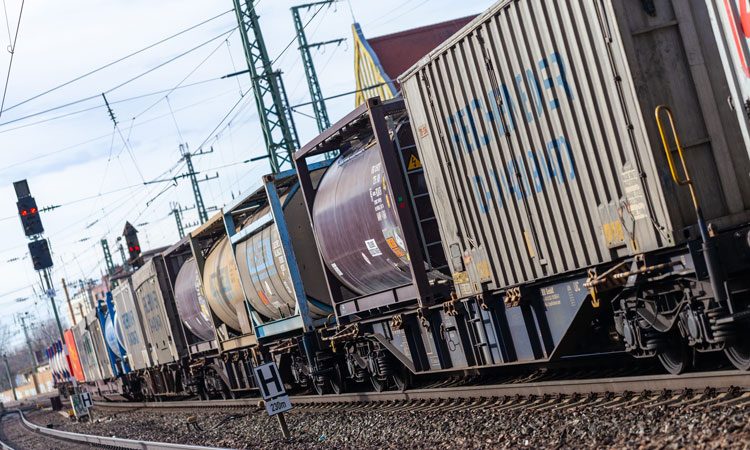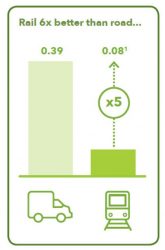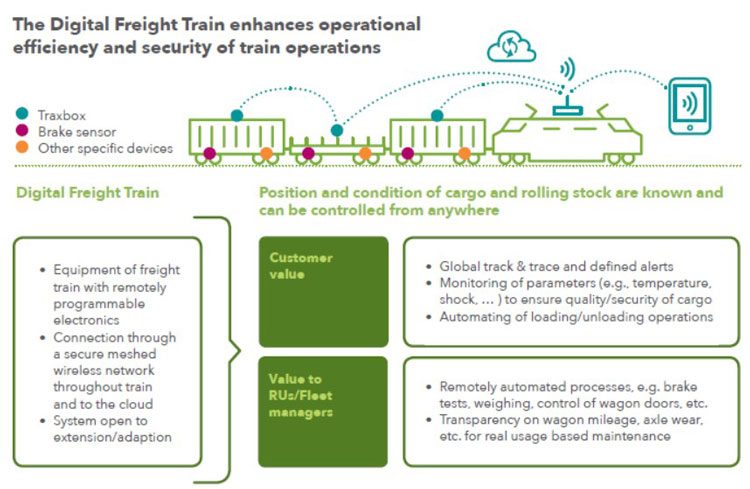Rail freight in the next decade: Potential for performance improvements?
Posted: 2 September 2019 | Libor Lochman | No comments yet
Moving freight by rail is no doubt the most energy-efficient means of land-based transportation, but as Libor Lochman, Executive Director of the Community of European Railway and Infrastructure Companies (CER) explains, more must still be done to entice potential customers onto rail and achieve a modal shift for freight.


The year 2019 marks an important milestone for the European Union, with the renewal of the European Parliament and the appointment of the next College of European Commissioners. This is the time to take a close look ahead at the rail objectives, priorities and challenges of the new European policy term. The railway sector is ready to contribute to finding the best way forward, as comprehensively addressed in the CER Policy Agenda 2019-20241.
Rail: A crucial transport mode for society and the economy
Moving goods by rail is indisputably the most energy-efficient means of network-based land transportation (as inland waterways lack enough territorial coverage). It is therefore also the most carbon-efficient motorised means of transport: CO2 emissions from rail account for less than three per cent of CO2 emissions from transport although it carries 17 per cent of freight.
In addition, total decarbonisation of rail transport is within reach: In fact, today, four out of five trains are already running on electricity, which is itself becoming greener.


Comparison of energy efficiency in kWh/tonne-km specific energy input, 2017
SOURCE: Rail Freight Forward White Paper3
As such, rail can significantly contribute to the low-emission economy that is more and more demanded by European society.
The International Monetary Fund calculated that one per cent of GDP investment in rail brings 1.5 per cent extra GDP over four years. Investing in further rail capacity offers more mobility options to workers and is therefore an important factor in enlarging the size of the available labour market to companies, while investing in the wider availability of transport facilities for certain industries is enhancing the productivity of companies.
Moreover, let’s not forget: The safety record of the rail system is unparalleled and continuously improving. The high level of automation coupled with the rail safety culture developed over the last century make railways one of the safest modes of transport and certainly the safest mode of land transport.
Default conditions are in place, but do we meet the customers’ expectations?
Current low modal share demonstrates that rail freight is not attractive enough for a wider spectrum of potential customers. A lot will have to be done to bring them back on track.
Ports and terminal operators as well as container shippers will have to be able to find in rail a logistics partner increasingly able to forward semi-finished and higher added-value products in a seamless logistics chain. While the share of raw materials for heavy manufacturing will likely decrease, the proportion of markets where rail has traditionally been less present than other modes must increase.
Improved performance is the key – railway operators will therefore be adapting their services to accommodate the needs of shippers in an increasingly efficient manner, e.g. by maximising the use of available train capacity and mixing different types of freight services (full trainload, single wagonload, multimodal).
In this context reliable transit times and attractive rail and multimodal transport solutions will continue to be developed by rail freight operators in order to meet customers’ needs.
How to achieve the modal shift?
Rail sector commitments
1. Digitalisation
Railways embrace technological innovation and the implementation of new digital solutions to provide better services and attract new customers.
Railways are therefore committed to a series of actions in the digital sphere that will deliver efficiency gains and system cost reductions:
- Investing in ERTMS enhanced functionalities, including the integration of ERTMS with automated train operation (ATO), satellite-based localisation and the future rail mobile communication system (FRMCS)
- Implementing advance sensor systems to shift from preventive to predictive maintenance of both infrastructure and rolling stock
- Fostering the acceptance of electronic exchange of information for freight
- Improving information flows for freight customers with ETA information and effective tracking solutions, e.g. by using digital freight trains made of wagons communicating with each other thanks to a common standard allowing more efficient operations and sharing of relevant data between the relevant actors.
Meeting these commitments will have to go hand-in-hand with information and technology security in all initiatives.
2. Sustainability as a driver for modal choice
Rail undertakings are committed to reducing their CO2 footprint and the sector has established its own sustainable mobility strategy with the aim of achieving carbon-free rail operations by 2050. In the meantime, railways are already well on the way to meeting their 2030 target of reducing their total CO2 emissions from railway operations by 30 per cent compared to 1990 (and this notwithstanding the expected modal shift goals of the 2011 Transport White Paper).
The sector will demand an increasing share of energy from renewable sources, it will invest in major fleet renewals, it will implement new technology able to recover energy from braking, new technology towards automated train operations and will invest in further training of and technology for its drivers and infrastructure staff for efficient energy consumption.
3. Sustainable financing models for railways
Given the budgetary situations of many Member States, the EU and national funding sometimes cannot cover all the funding needs for tomorrow’s railway system. Policymakers have therefore recently turned their attention to investigating and fostering the possibility of private investment in rail projects.
Railways will also reflect more deeply upon what role private money can play in rail financing, to what extent portions of the railway system can more easily attract private investors, and what kind of private investors could be the best partners for the sector.
4. Embracing new market opportunities
Freight volumes between Europe and Asia on the Eurasian corridor and via the Silk Road are rising quickly. Railways therefore aim to further strengthen their Eurasian transport operations and implement high-frequency connections between Europe and Asia. Rail customers will benefit through comprehensive transportation from a single source as well as shorter transport times.


The Digital Freight Train enhances operational efficiency and security of train operations
SOURCE: Rail Freight Forward White Paper3
Can policymakers help?
In the new 2019-2024 political term, the significance of rail for the society, the economy and the environment should be emphasised. The important role of railways as employers, investors, drivers for economic growth and cohesion, and as a central tool in the fight against climate change in Europe should be mirrored in the Union’s future policy agenda and supported at national level with concrete actions of implementation and enforcement.
The railway sector expects policymakers to progress in the following five key areas:
1. Ensuring a stable regulatory environment in the railway sector
The sector-specific EU legislation for market governance has reached a sufficiently high density and level of detail. In the coming years, the existing body of legislation should be fully transposed into national law, implemented in practice and controlled by the regulatory bodies before an assessment of its effectiveness can be performed. There is no need for a Fifth Railway Package.
2. Reducing technical barriers, promoting digitalisation and innovation
The implementation of the technical pillar of the Fourth Railway Package, for example as regards the rules for an effective vehicle authorisation process, and a close cooperation with the European Union Agency for Railways, is of key importance for the sector. The goal is to reduce the excessive volume of regulations/rules applicable for operating freight trains, and thereby the high costs incurred by the rail companies.
The deployment of ERTMS should be a centrepiece of the EU’s technical strategy in order to let its advantages materialise (e.g. technical and operational harmonisation, increased capacity on the network, improved reliability, reduced maintenance costs).
In addition, developing the technical and legal framework for the increasing levels of automatic train operation, improved data connectivity along train routes (e.g. through the rollout of 5G technology) as well as further digital developments relevant for rail should be at the top of the agenda.
In the policy period as of 2019, EU support to boost innovation in the rail sector is also needed, in particular, regarding the continuation of the Joint Undertaking Shift2Rail. Continuing on the path of progressive digitalisation will also enable better multimodal cooperation with more efficient logistics chains for freight. In this context, more international provisions should be adjusted in order to ensure digitalisation of all accompanying transport and customs documents.
3. Ensuring adequate funding
Adequate support from EU and national funds should be guaranteed for all portions of the rail system and for the completion of an effective European railway network including the bridging of missing links and upgrade of existing infrastructure.
The Connecting Europe Facility (CEF) needs to be continued and increased beyond 2020. CEF has already provided – and must continue to provide – a huge boost to the rail system: For studies and works related to new lines and the upgrade of existing lines, for on-board ERTMS as well as for noise-abatement measures. EU co-funding also helps secure the much-needed financial contributions at national level, which make up the lion’s share of rail investment in Europe.
The European Commission should also encourage spatial planning and industrial policies at Member State level that encourage grouping of industries in order to allow cargo bundling with limited last-mile operations. This could be done via special provisions linked to the European Structural and Investment Funds or by any other means of hard or soft legislation that would serve the same purpose.
4. Guaranteeing fair intermodal competitive conditions
In order to unlock its full potential, rail needs to operate in an environment of fair and comparable rules between the different modes.
A European Master Plan for Rail Freight, based on the existing examples in some Member States, should be developed.
Operational obstacles such as language requirements for train drivers need to be adapted to a changing technical environment and the actual needs.
The internalisation of external costs as addressed in the revision of the Eurovignette Directive should contribute to rebalancing the intermodal framework conditions of access to infrastructure.
5. Promoting environmental sustainability
Decarbonisation of transport should be a top priority in the upcoming policy period, putting rail at the heart of the EU decarbonisation strategy.
Amongst the measures applied, the European Commission should push Member States to waive part of the track access charges to compensate railways for the environmental, accident and infrastructure costs that go unpaid by competing transport modes, in so far as these costs exceed the equivalent costs borne by rail.
The ambition: 30 per cent of freight by rail by 2030!
Increased rail freight performance has the potential to deliver an ambitious target: A modal share of 30 per cent rail freight by 2030. This vision has been formulated by the Rail Freight Forward2 (RFF) coalition in 2018 as the best macro-economic solution for European economic growth.
The RFF vision is to transform rail freight into a high-performing, efficient and sustainable backbone transport system for a European multi-modal logistics industry. Without it, the EU’s economic development will be stifled by congestion, pollution and climate change.
The realisation of this ambition clearly requires decisive action not only from rail undertakings but also from infrastructure managers, policymakers and authorities.
By changing the way of doing business with more multi-modal solutions and by putting the prerequisites in place, the European rail freight sector is convinced that the ambitious target of 30 per cent by 2030 is achievable.
References
1. cer.be/publications/latest-publications/cer-policy-agenda-2019-2024
3. www.railfreightforward.eu/sites/default/files/downloadcenter/whitepaper-30by2030-150dpi6.pdf
Biography


Issue
Related topics
Cargo, Freight & Heavy-Haul, European Rail Traffic Management System (ERTMS), Sustainability/Decarbonisation
Related organisations
Community of European Railway and Infrastructure Companies (CER), Rail Freight Forward







